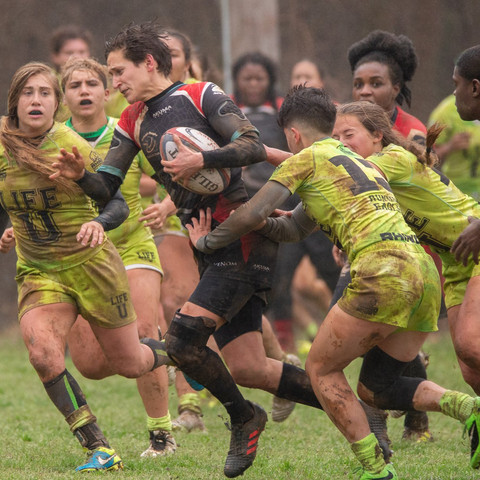Theory of the Ball Hog: How One Economist Sees the Rugby Field
- WRCRA Main

- Mar 8, 2021
- 5 min read
By Kerri Heffernan

Our next speaker feature for the 2021 WRCRA Conference is Chelsea Garber.
Chelsea was one of those rare players, smart, confident, athletic, and a leader. She had a gift for improvisation when play broke down–she saw the field differently from most players. By her junior year, Chelsea was asking interesting questions about the calculation of risk and reward on the field, as in “why would we do that?” or “what if we did this?”. Truthfully though, most often, she just did it.
Chelsea made me question assumptions about my coaching practice, primarily the ways passing exploited space. When asked to contrast men’s and women’s rugby, I tended to reiterate the common anecdote “women pass the ball more.” But is that true? How would one even begin to prove this? And if women do pass the ball more, is that a good thing? Are we rewarded for that altruism? Once I started to question the primacy of passing it sent me down other rabbit holes. Who is passing to whom? Are the links and strikers thoughtfully aligned? Or are the phases of the game really more serendipitous? And where on the field is most of the passing happening? Do the ways in which we pass inadvertently give our opponents an advantage? As a coach, can players rely on my knowledge and judgement to make sure that the risks they take on the field are rewarded?
Photos shared by Chelsea Garber
Between her junior and senior year, Chelsea won a fellowship to use tools from economics and statistics to examine patterns of passing and cooperation at the Women’s World Cup. Chelsea wanted to understand the outcomes of player decisions and the cost/benefit of cooperation on the field. Her findings were fascinating and the math was incontrovertible; the teams at the top had similar passing patterns, often dramatically different from the mid-lower level teams.
Now, years later, Chelsea is an award-winning economics instructor at Duke, a law student for fun, a seasoned D1 player, and a level 200 coach. She combines those experiences into a unique and evolving understanding of coaching. Over the course of a recent conversation I asked Chelsea what advice she would give coaches: “Most coaches tend to ’under-coach’ the big picture and micro-manage the small skills. For instance, coaches should spend more time on the choreography of the first 3 phases off set pieces. Statistically it’s very difficult for a team to possess the ball for more than 6 phases. If you choreograph those phases to emphasize possession the odds are that you’ll score 85% of the time.
Later in the conversation Chelsea, offered: “Coaches should keep in mind that all teams will have unequal distributions of talent. For instance, you will have players on the team who statistically make more tackles. Which means other players are making far fewer tackles. The goal is not to make everyone on the team a devastating tackler, the goal is to find an equilibrium in which what each player does well can best serve the team.” Our conversation wandered into the cost/benefit of kicking, player specialization, and improvisation. Chelsea's ability to think about rugby from multiple perspectives makes her unique, but it’s clear that her ability to think about risk and reward is what sets her apart.
Chelsea, who is a fan of the movie Moneyball, cautions that this isn’t about coaches delving into sport analytics, coding film, and surrounding themselves with data. Instead, to think in terms of risk and reward is really to think about the larger assumptions that shape our coaching philosophies and practices, expanding our own fields of view.
Photos shared by Chelsea Garber
One of the best stories I ever read about risk and reward is the story of the Redwood City Girls 7th and 8th grade basketball team. In 2009, Vivek Randadivé volunteered to coach his daughters team. Vivek didn’t know much about basketball–he had grown up in India and the few times he’d watched basketball he was perplexed by the strategy. “Team A would score and then immediately retreat to its own end of the court. Team B would inbound the ball and dribble it into Team A’s end, where Team A was patiently waiting. Then the process would reverse itself. A basketball court was ninety-four feet long. But most of the time a team defended only about twenty-four feet of that, conceding the other seventy feet.”
Randadivé wondered, why would a team that lacked skill or athleticism agree to play a style of basketball that favored the skill and athleticism of the opponent? Ranadivé knew that if his team played the conventional way—if they let their opponents dribble the ball up the court without opposition—Redwood would almost certainly lose. So, Randadive built a strategy around contesting the inbounds pass. “Think about football,” Ranadivé said. “The quarterback can run with the ball. He has the whole field to throw to, and it’s still damned difficult to complete a pass.” Basketball was harder. A smaller court. A five-second deadline. A heavier, bigger ball. As often as not, the teams Redwood City was playing against simply couldn’t make the inbounds pass within the five-second limit. Or the inbounding player, panicked by the thought that her five seconds were about to be up, would throw the ball away. Or her pass would be intercepted by one of the Redwood City players.”
Randadivé offered that his approach brought the game into the girls' realm of understanding. As a result, there was no pause, no deliberation, just players who knew their job and did it as hard as they could for as long as they could. Randadivé, who knew very little about basketball, understood he could exploit the assumptions others made about how to play basketball. He simply made very different calculations about the game, and in the long run, his math was better.
Like Randadive, Chelsea makes different calculations. She understands that for coaches, each season is a series of math problems. Coaches must get 23+ players with diverse strengths to work together to advance the ball down the field and score points. Successful and confident coaching comes not from sorting through the right drills for practice, rather it comes from understanding the calculation and choreography of rugby. This is the essence of game theory, teaching players how to react strategically to an opponent, teaching teammates to strategically interact with each other. In a related conversation Chelsea offered, “Practice MUST be a place players can take risks. Coaches who adhere to the line, ‘that's not how it’s played’ are too risk averse or just making the wrong calculations.”
To register and hear more from Chelsea,
please visit our Conference Homepage














The tension rises when Escape Road throws unpredictable twists that demand sharp reflexes and perfect control under pressure.